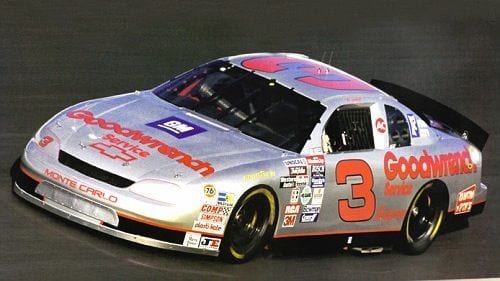
Fred Wagenhals approached Richard Childress in February 1995 with a radical idea he wanted to turn into a reality.
R.J. Reynolds Tobacco Co. was celebrating its 25th year — the silver season — of sponsoring NASCAR’s top series in 1995, and Wagenhals, the founder of marketing and merchandise giant Action Performance, had a pitch for Childress and driver Dale Earnhardt.
First, Wagenhals met with Don Hawk, the president of Dale Earnhardt Inc., and Joe Mattes — Earnhardt’s souvenir chief — with a proposal: to turn Earnhardt’s No. 3 GM Goodwrench car from black to silver for one race.
“Fred was one of the most creative people in our sport,” Childress recalled. “He came to me and asked me and I said, ‘Let me run it by Goodwrench.’ I was able to sell them on it.”
Childress and Hawk then went to Earnhardt, the seven-time and defending NASCAR Cup Series champion, for his approval. Earnhardt fit the badass, man-in-black persona he’d gained by driving a black car for seven years, but he was an astute businessman who could be persuaded if an idea was good enough.
“The main focus was, ‘How in the heck are we going to tell The Man in Black that we’re changing the color of his car?’” Hawk recalled.
Earnhardt listened to the group’s idea, examined a rendering and thought for a moment.
“Does T. Wayne (Robertson, RJR’s sports marketing guru) like it?” Earnhardt asked. “I’m not doing it unless T. Wayne likes it.”
To go from the drawing board to the race track, the silver car had to pass muster with Childress, GM Goodwrench, Earnhardt, RJR and finally, Robertson — who gave his blessing.
“Dale thought very highly of T. Wayne,” Hawk said. “If T. Wayne was good with it, it was happening. If he wasn’t, it was off the table. And remember, Dale was a superstitious driver, just like many of the old-school guys, so he wouldn’t run a different-colored car in a points race. That’s why we decided to race it in the All-Star Race at Charlotte Motor Speedway.”
Earnhardt and Childress drafted Sam Bass — NASCAR’s first officially licensed artist — to develop the car’s paint scheme.
“There were three or four designs that had little tweaks,” Childress remembered. “One didn’t have the black trim on the bottom of the car. We changed the tone of silver a couple times and the tone of the numbers.”
The final result was a striking, silver Monte Carlo with black trim and orange decals that seemed to pop right off the car. Changing a paint scheme for a single race was unheard of — and Childress made sure that even members of his eponymous team were kept in the dark about it. Long before the days when a crewman could snap a photo, post it to Twitter and ruin the surprise, only a small group knew what was coming.
“We kept that car at a special body shop under a cover,” Childress said. “Bobby Moody painted the car overnight and we had a couple guys do the lettering. It was all done within the body shop, and it was done at night so nobody could see it. It still had the cover on it when it got to the race track. Seeing the change from that black car every week in and week out, that big a change was pretty strong for Dale Earnhardt.”
In the race, Earnhardt made a three-wide pass of Jeff Gordon and Darrell Waltrip on the first lap of the 10-lap trophy dash.
However, the aggressive maneuver left Earnhardt over-driving the entry of turn three. He got loose, slid into Waltrip and both cars slammed into the frontstretch wall. Gordon emerged unscathed and drove to victory.
The silver car altered not only NASCAR’s future regarding special paint schemes, it changed the way Childress ran his race team.
“The biggest thing I remember that came out of that whole thing was, I don’t think Dale knew Darrell was out there (when the cars collided),” Childress said. “From that time on, we had a spotter. Dale didn’t want a spotter. He’d always say, ‘I know how to drive the damn car.’ He did, but we used a spotter from that point on.”
In ensuing All-Star Races, Earnhardt ran one-off cars featuring the 1996 Olympic Games, Wheaties, Bass Pro Shops, Wrangler and Peter Max. None compared to the silver car, which now resides in Childress’ museum in Welcome, N.C.
